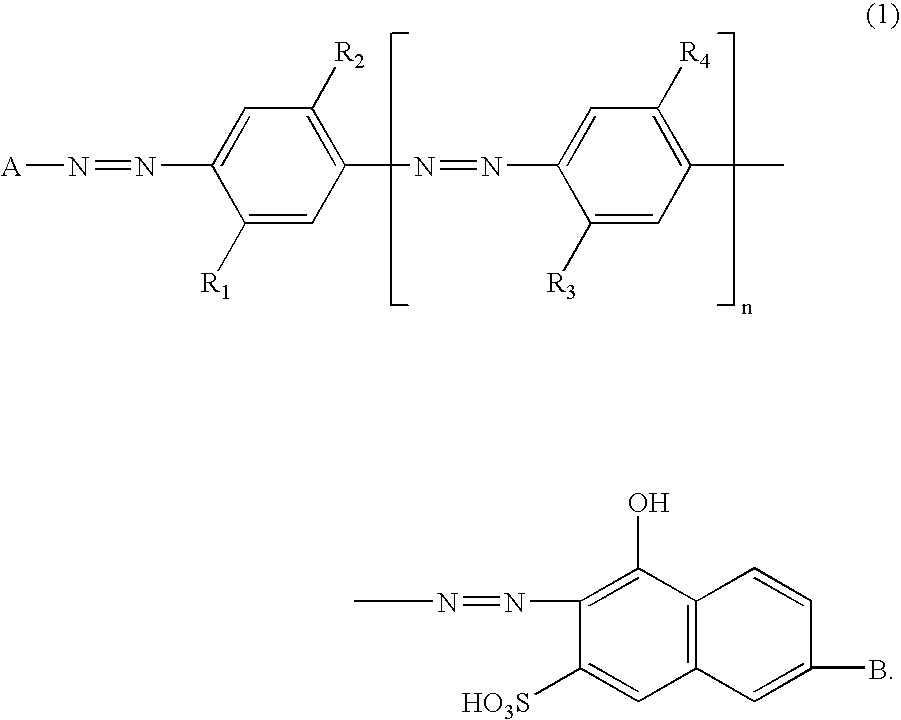Dye type polarizing plate
a polarizing plate and polyvinyl alcohol technology, applied in the field of dye type polarizing plates, can solve the problems of insufficient initial polarizing performance, insufficient insufficient light fastness, heat resistance and wet heat resistance, etc., and achieve excellent brightness and polarizing performance of high-performance polarizing plates.
- Summary
- Abstract
- Description
- Claims
- Application Information
AI Technical Summary
Benefits of technology
Problems solved by technology
Method used
Image
Examples
synthesis example 1
, Synthesis of Compounds No. 1 and No. 16.
[0089](a) 29.9 parts of 4-aminoazobenzene-4′-sodium sulfonate were added to 600 parts of water and dissolved at 70° C. They were cooled to 30° C. or lower and 32 parts of 35% hydrochloric acid were added and then 6.9 parts of sodium nitrite were added and stirred at 25 to 28° C. for 2 hours. After adding 12.1 parts of 2,5-dimethyl aniline and stirring at 25 to 30° C. for 2 hours, pH was adjusted to 3 with addition of sodium carbonate and stirring was conducted further to complete coupling reaction, and filtration was conducted to obtain a disazo compound. After dispersing the resultant disazo compound into 600 parts of water, 32 parts of 35% hydrochloric acid and then 6.9 parts of sodium nitrite were added and stirred at 25 to 30° C. for 2 hours to conduct diazotize.
[0090]On the other hand, 35.8 parts of N-(4′-aminobenzoyl)J acid were added to 250 parts of water, rendered weakly alkaline with sodium carbonate and dissolved. The diazotization...
synthesis example 2
, Synthesis of Compound No. 2
[0092]17.3 parts of sulfanyl acid were added to 500 parts of water and dissolved with sodium hydroxide. They were cooled to 10° C. or lower and 32 parts of 35% hydrochloric acid were added and then 6.9 parts of sodium nitrite were added and stirred at 5 to 10° C. for one hour. 13.7 parts of p-cresidine dissolved in an aqueous diluted hydrochloric acid were added and, while stirring at 10–15° C., adjusted to pH 3 with addition of sodium carbonate and stirred further to complete the coupling, and filtered was conducted to obtain a monoazo compound. After dispersing the resultant monoazo compound into 600 parts of water, 32 parts of 35% hydrochloric acid and then 6.9 parts of sodium nitrite were added and stirred at 25° C. to 30° C. for 2 hours. 15.3 parts of 2,5-dimethoxyaniline dissolved in an aqueous diluted hydrochloric acid were added and while being stirred at 20 to 30° C., adjusted to pH to 3 with addition of sodium carbonate and stirred further to c...
synthesis example 3
, Synthesis of Compound No. 3
[0094]40 parts of the compound obtained in Synthesis Example 2 were dispersed in 500 parts of water and 15 parts of crystalline copper sulfate and 15 parts of monoethanol amine were added and heated to 95° C. and reacted for 10 hours. The reaction solution was salted out with addition of sodium chloride and filtered to obtain a copper complex salt dye (Na salt) as Compound No. 3.
PUM
| Property | Measurement | Unit |
|---|---|---|
| absorption wavelength | aaaaa | aaaaa |
| absorption wavelength | aaaaa | aaaaa |
| light transmittance | aaaaa | aaaaa |
Abstract
Description
Claims
Application Information
 Login to View More
Login to View More - R&D
- Intellectual Property
- Life Sciences
- Materials
- Tech Scout
- Unparalleled Data Quality
- Higher Quality Content
- 60% Fewer Hallucinations
Browse by: Latest US Patents, China's latest patents, Technical Efficacy Thesaurus, Application Domain, Technology Topic, Popular Technical Reports.
© 2025 PatSnap. All rights reserved.Legal|Privacy policy|Modern Slavery Act Transparency Statement|Sitemap|About US| Contact US: help@patsnap.com



